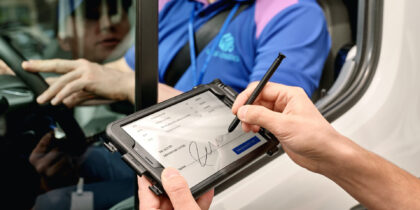For trucking fleet managers, meeting the new federal regulations for electronic logging can seem like a complex undertaking. Depending on the fleet type, size and existing in-cab devices, each trucking organization has carved its own path to compliance with the ELD (electronic logging device) mandate — or is facing a looming deadline.
Under the Federal Motor Carrier Safety Administration (FMCSA) regulations, most commercial trucks were required to carry ELDs to record the driver’s hours of service (HOS) duty status as of December 18, 2017. FMCSA has delayed out-of-service orders for non-compliance until April 2018. There are also some exemptions for certain types of fleets, and fleets with older onboard recording devices have an extra two years to update to ELDs.
Also, keep in mind the HOS regulations haven’t changed. The only thing that’s changed is the way in which the drivers’ hours are recorded, displayed and stored using the ELD. Enforcement and procedures are still taking shape as the industry and law enforcement comes to grips with the reality of ELDs on the road.
For fleet managers looking to understand where they stand, here are three potential scenarios that large and small fleets might find themselves in as they consider the new ELD-mandate environment:
1. You’ve Met the ELD Mandate: Now What?
If your fleet has already outfitted all vehicles with ELDs, congratulations. This is also a great opportunity for going beyond the ELD mandate and adding more capabilities for drivers and dispatchers. In addition to recording duty status, most ELD options include additional functionality such as navigation and mapping, driver visual inspection records and IFTA reporting. Fleets can leverage these capabilities to do more and make deliveries as accurate as possible.
Dispatchers can see how much time a driver has left without contacting them by phone, email or text. ELD systems that interact with dispatching systems can populate load data such as shipper numbers and bill-of-lading information to save drivers’ time.
High-level ELD equipment will automatically track driver arrival, departure and detention time for better customer communication and back-office support. Drivers can capture more driving time by tracking their status down to the minute rather than in 15-minute increments.
Smart devices can also support fleet telematics for greater fuel efficiency, electronic delivery records and a host of other capabilities that can make life better for drivers and more profitable for fleets.
2. You Have AOBRDs That Are Grandfathered in for Two Years
Trucks that already have an automatic onboard recording device (AOBRD) are grandfathered in until December 16, 2019. AOBRDs offer the same basic functions of the ELD, but most fall short of the total requirements for device functionality, displays and operations.
The delay is designed to give AOBRD users extra time to make the device compliant with the ELD mandate or to replace it altogether. Depending on the age and technology of an AOBRD, it may be upgraded to meet the ELD standards. Fleets that upgrade to ELD systems will tap into the benefits of enhanced communication, record keeping and efficiency. If the AOBRD cannot be upgraded, switching to ELD will make it easy to address future regulations or required upgrades since companies will not have to replace as many devices.
The Future of Fleet Management
Get this guide on going beyond the ELD mandate and becoming a fleet management technology leader. Download Now
The key here is not to leave your decision until the last minute. Implementing a full ELD solution offers a number of benefits that will make fleets more efficient and better for drivers. Drivers and dispatchers will be able to communicate better, and drivers will have more control over their duty status. There’s typically a learning curve that drivers and managers must follow during ELD implementation, so fleets should start moving to ELD as soon as possible to make sure everyone is comfortable with the system.
3. You Are Non-Compliant, But Don’t Panic
The FMCSA has announced a grace period until April 2018, during which a non-exempt truck can operate without an ELD and not be pulled out of service, but could still be subject to points added to a driver’s or fleet’s Compliance, Safety, Accountability (CSA) score. After the grace period, a truck can be pulled out of service until a qualifying device is installed.
There are exemptions for certain types of trucking fleets, including agricultural and driveaway-towaway operations, as well as trucks older than 2000. Some agriculture and livestock haulers received a last-minute 90-day reprieve due to the unique nature of moving live animals.
Even if you are in these exemption categories, it’s time to make the jump to the ELD. Samsung can help with its package offering the Omnitracs XRS ELD and fleet management application on its rugged tablets. The solution provides fleets with key driver performance analytics, including fuel usage, drive time, speed, driving behavior, driver vehicle inspection reporting (DVIR) and trip data to improve driver safety, lower costs and increase productivity.
For fleets with concerns about meeting the deadlines, working with service providers can help ease the installation process, lower costs and make it simple to customize the solution for specific company or fleet needs.
While trucking companies must properly evaluate systems to find the best fit to ensure compliance, adhering to the ELD mandate is the beginning of using technology to improve trucking fleet efficiency and as well as the lives of the drivers.
See what connected fleet solutions are available to help you meet company and driver needs.












